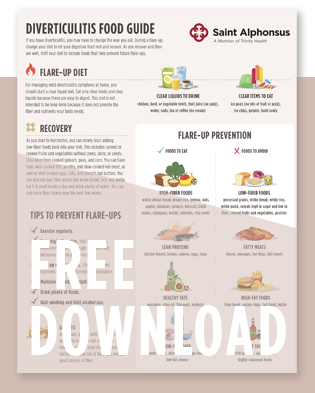Diverticulitis is a complication that can affect people with diverticulosis, which are small pouches that bulge outward through weak spots in your colon. For people with diverticulosis, when one or more of these pouches become injured or infected, it can cause inflammation and a sharp pain in the lower abdomen. These flare-ups may occur suddenly and can sometimes cause serious health problems.
Certain foods may help prevent flare-ups and further complications. For instance, a healthy diet full of fiber-rich foods can help lower your risk. Whole grains, such as whole grain breads, quinoa, barley, oats, shredded wheat or bran cereals are high in fiber, as well as kidney beans, chickpeas, lentils, spinach, broccoli, cauliflower, fruits, and nuts are great sources of fiber and recommended for people with diverticulosis.
When starting a high-fiber diet, go slow. It may take a while for your digestive system to get used to the change. Gas and bloating are normal when getting used to a higher fiber diet. Stay well hydrated, this helps your bowels stay healthy and function properly. Aim for the number of ounces of water you consume in a day to equal half of your weight in pounds. For example, if you weigh 160 pounds, aim for about 80 ounces of water each day.
There are many benefits of a high-fiber diet. In addition to helping prevent diverticulitis flare-ups, high-fiber foods may also help regulate blood sugar, lower cholesterol, reduce the risk of colorectal cancer, and assist with weight control by helping you feel fuller longer.
Download our Free Food Guide
For more dieting tips to help prevent diverticulitis flare-ups, including what to do during a flare-up and when you’re recovering from one, download our free food chart to keep as a handy reference.



